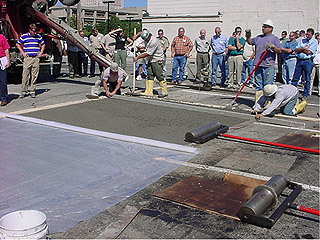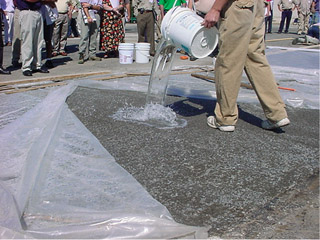|
Subscribe / Renew |
|
|
Contact Us |
|
| ► Subscribe to our Free Weekly Newsletter | |
| home | Welcome, sign in or click here to subscribe. | login |
Construction
| |
 |
May 2, 2008
Pervious concrete gets the Midwest test
Cleveland State University

Delatte
|
When property is developed, pavements and building roofs decrease the rainfall infiltration into the soil and increase the quantity of stormwater runoff. The rain that previously soaked into the ground runs across parking lots and into storm sewers. If there is too much impervious cover from development, the storm sewers can be overwhelmed and flooding may occur.
One alternative is the use of pervious concrete pavement for parking lots. Unlike conventional concrete or asphalt, the pervious concrete has an open structure that permits water to flow directly through it, allowing infiltration and decreasing runoff. In southeastern states such as Florida and Georgia, pervious concrete has been used for some time to mitigate the environmental impacts of development, and has been recognized as an effective solution to stormwater runoff problems.
Expanding to the north
In Florida, of course, it doesn’t snow. The success of pervious concrete in milder climates has led to increasing interest into expanding the use of the technology into other areas of the country.
As the use of pervious concrete has spread throughout the U.S., questions have arisen as to how it will hold up in environments that are subject to cycles of freezing and thawing. Since water expands when it freezes, it can generate forces within materials that can break them apart.

Conventional concrete is protected from freezing and thawing by mixing in (entraining) a network of fine air bubbles. The air bubbles provide room to allow the water in concrete to expand safely. It has proven difficult, however, to get these air bubbles into pervious concrete.
Therefore, the question to be investigated was: “Can pervious concrete withstand the harsh winters of the Midwest?” A research team from Cleveland State University investigated about two dozen pervious concrete pavements in Ohio, Indiana, Kentucky, Pennsylvania and Colorado. The report can be viewed online at http://www.rmc-foundation.org/newsite/index.htm .
The RMC Research & Education Foundation provided funding for the research.
The research team was looking for evidence of two possible failure mechanisms for pervious concrete pavements. The first was deterioration due to repeated cycles of freezing and thawing, which would eventually result in disintegration. This mechanism was observed in concrete often before the use of air entraining became common several decades ago.
The other possible failure would be clogging of the system with fine particles that would destroy the pavement’s ability to allow water to pass.
Field and lab investigations

Each of the sites was carefully inspected visually, and a number of surface drainage tests were performed. These tests noted the time required for a known volume of water to drain through the pavement. Ultrasonic pulse velocity tests were used to measure wave speeds through the concrete, which can give an indication of in-place density and quality.
At some of the sites, the research team obtained permission to drill and extract cores for laboratory testing. These cores could be subjected to more detailed flow and strength testing in the laboratory. They could also be carefully inspected for any signs of damage due to freezing and thawing.
The observations were supplemented whenever possible by interviews with the owners of the facilities, as well as the concrete suppliers and contractors. They often provided valuable insights into any problems that had arisen during construction, as well as any overloads that may have occurred during the use of the facility. In one instance, fire trucks had routinely stopped and filled water tanks on a pervious concrete pavement that had only been designed for light duty. That pavement didn’t hold up.
Research results
Most of the sites visited were in good structural shape and had retained their overall permeability. No evidence of damage due to freezing and thawing was observed. Much of the clogging observed could be removed with maintenance such as vacuuming or pressure washing.
Two possible sources of clogging were identified: landscape soil washing onto the pavement, and adjacent deteriorated asphalt pavements. A test site at Cleveland State University was placed in the middle of a large, badly deteriorated asphalt parking lot, and the edges have become clogged with debris. In some of these cases, however, the clogging is limited to the edges of the pervious concrete pavement and the interior continues to drain well.
It should be noted, however, that most of the sites were only a few years old at the time of the investigation. It would be useful to revisit these sites in the future and see how they continue to hold up over time.
One common theme is that pervious concrete pavements are very sensitive to proper concrete mixtures and installation. Some sites that had overly wet mixtures or that were over compacted did not drain well. These were not cases of clogging — the investigation showed that these pavements probably never drained correctly.
Washington sites
At least 10 pervious concrete installations have been placed in Washington state so far. A list can be found at http://concretepromotion.org/states/wa.htm. Many of these are sidewalks or small parking lots, but a large 32,000-square-foot pavement was installed at Stratford Place in Sultan, Snohomish County. There are probably other sites in the Pacific Northwest that have not yet been entered into the data base.
Recommendations
It is necessary to use care during construction to avoid sealing off the surface. The National Ready Mixed Concrete Association recommends the use of certified contractors and has developed a Pervious Concrete Contractor Certification Program.
A properly designed pervious concrete pavement system will allow water to flow through, and will not become saturated. This is important, because the damage due to freezing and thawing occurs mainly when the pavement is saturated, and these conditions can be avoided.
With proper attention to design, mixtures and construction, it is possible to make wider use of pervious concrete throughout the U.S. It is important to be careful in locating pervious concrete pavements so that soil from landscaping and other debris doesn’t clog them.
Norbert Delatte, PE, Ph.D., is a professor at Cleveland State University. His research includes concrete pavement performance and rehabilitation, nondestructive testing, properties of concrete and the integration of failure case studies into the university’s civil engineering curriculum.
Other Stories:


